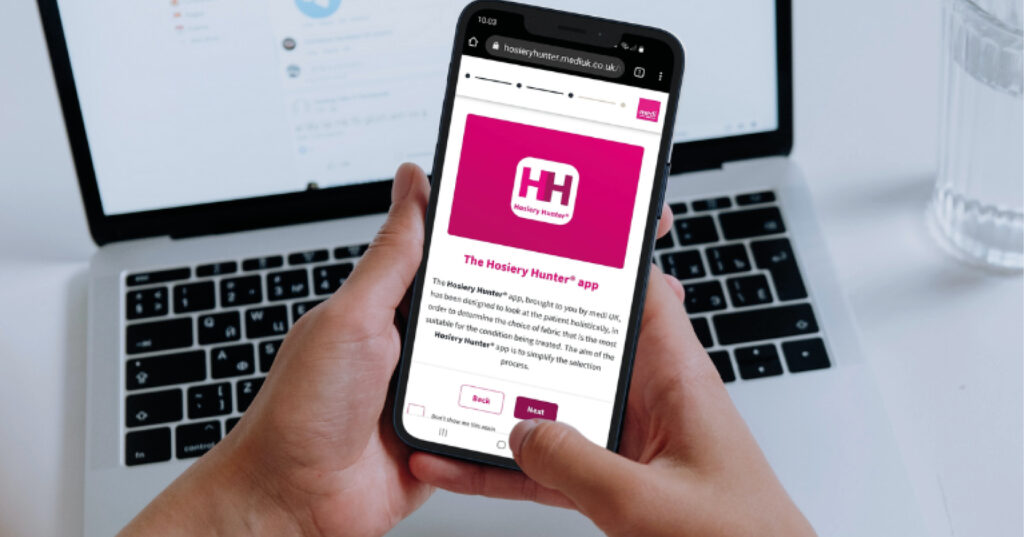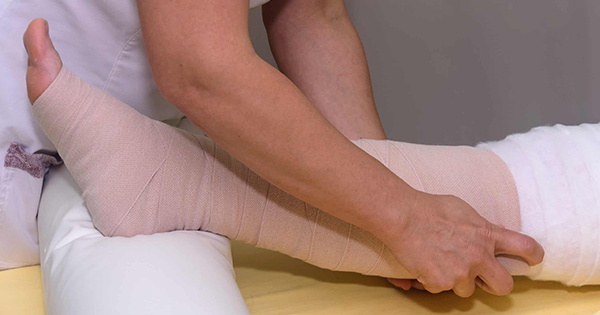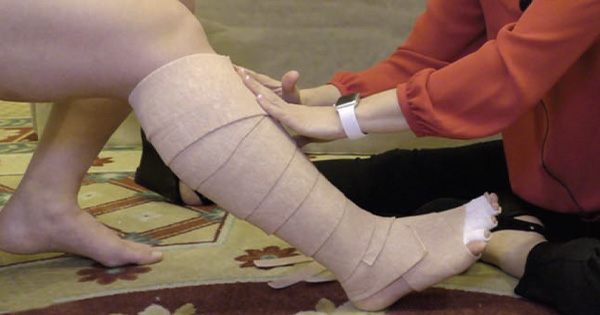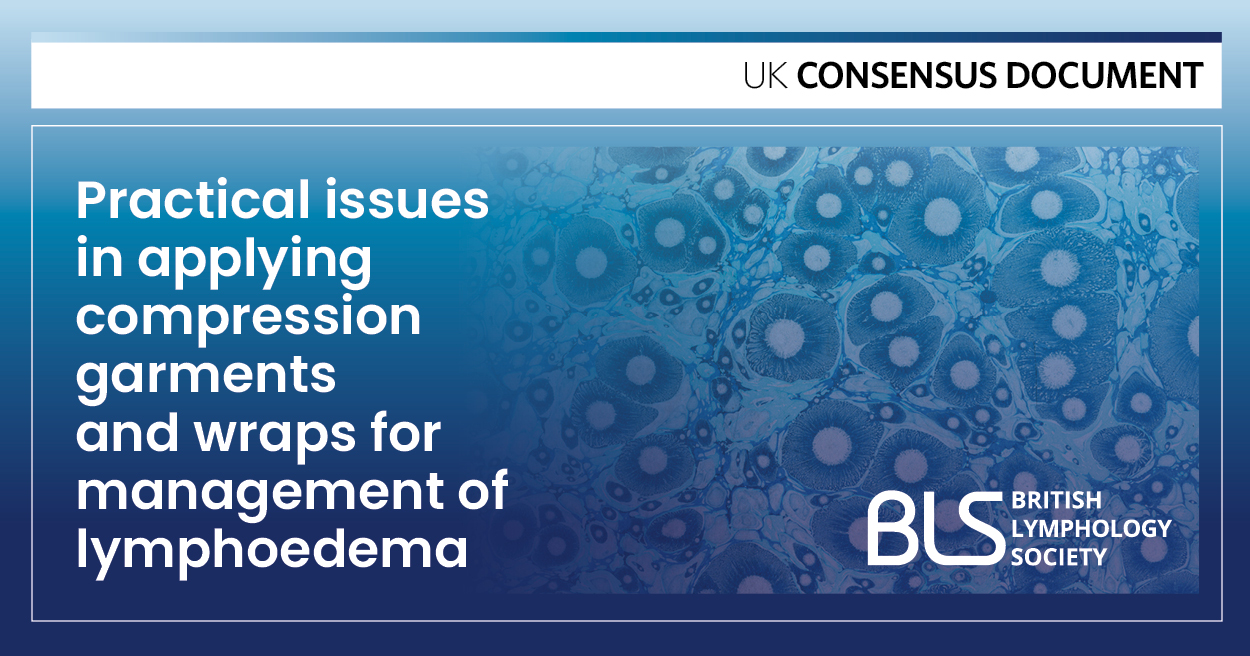Compression therapy is widely accepted as an evidence-based treatment for both the prevention and management of venous leg ulceration (National Institute for Health and Care Excellence [NICE], 2016). In particular, NICE guidance states that compression therapy is necessary for treating conditions associated with chronic venous insufficiency, including venous ulcers, varicose veins, venous eczema, post-thrombotic syndrome and lipodermatosclerosis (NICE, 2018).
In the case of preventing venous leg ulcer recurrence, putting patients into mild to moderate compression therapy can help protect their legs from more serious complications. Skin maintenance is critical after an ulcer has healed, as without the correct treatment, they can be recurrent and persist for months or years. In order to prevent recurrence, clinical guidance currently recommends that people continue to wear compression even after their ulcers heal. Compression therapy can also help reduce the incidence of long-term pain and swelling of legs in patients with deep vein thrombosis, and early compression can be useful for the ongoing management of post-thrombotic syndrome.
Although considered to be a critical area of lower limb wound management, compression therapy may not be initiated, utilised or maintained due to: unclear referral pathways, local unavailability of bandages or hosiery (Harding, 2016) and a lack of clinician skill, knowledge, resource, time and confidence (Wounds UK, 2019). Moreover, there are reports of inappropriate use of compression therapy in the treatment of venous leg ulcers – e.g. clinicians incorrectly perceive that patients refuse to have or are unable to tolerate compression (Samuriwo et al, 2020).
There is an urgent need to implement strategies to improve lower limb care and reduce unwarranted variation. For example, in recent years, the number of mobile apps for healthcare professionals has increased exponentially (Mayer et al, 2019). This recent development of mobile apps in healthcare brings opportunities for significant improvement in clinical practice and in areas such as wound care (Shamloul et al, 2019). There is evidence to show that UK-based clinicians use mobile smartphones regularly, including within their clinical work, but they do not currently use mobile apps focused on wound care (Wynn and Clark, 2022). There are examples of a high reported usage of mobile health apps, such as in dietetic practice where technology is used as an information resource (Chen et al, 2017). Therefore, clinicians may benefit from referring to other disciplines for examples of successful methods of introducing mobile app technology into practice, to restructure working patterns and help improve patient management practices for venous insufficiency.
Challenges of compression therapy
While compression therapy is regarded as the mainstay treatment for patients who have developed a lower limb wound (Atkin and Byrom, 2022), many individuals do not receive appropriate compression therapy (Harding, 2016). A study by Perry et al (2022) found that the provision of compression is challenging due to organisational barriers, including heavy/increasing workloads, lack of knowledge/skills and training and prescribing issues. Patient engagement barriers have also been identified, with some patients finding compression uncomfortable or challenging to wear during hot weather (Perry et al, 2022; Lian et al, 2023). See Figure 1 for additional challenges in selecting effective compression therapy. It is important to bear in mind that putting patients in the wrong type of compression for their condition can also impact patient engagement.
There is a lack of robust training and education on hosiery selection (Lian et al, 2023); therefore, an overreliance on a limited range of products can lead to incorrect or inappropriate garments being selected, resulting in sub-optimal care. Lee and Wigg (2012) found that within the community nursing setting, knowledge and confidence levels were low in the selection of appropriate hosiery for the management of oedema.
Due to a lack of confidence or limited knowledge, some clinicians often rely on ‘playing it safe’ and not selecting a strong/stiff enough compression level, which renders the therapy ineffective. There are also challenges with proper application of compression therapy. Clinicians can have misconceptions that a certain level of compression will be too tight for the patient when this may not be the case. There are misconceptions that British Standard compression hosiery is easier to put on patients; however, for some patients, stiffer garments are easier to manage.
Understanding compression therapy interventions
Medical compression is often a lifelong therapy and needs to fit within the patient’s lifestyle. There are different types of medical compression garments that can be prescribed depending on the severity of the patient’s condition, underlying causes and their preferences, including:
- Compression wraps
- Compression hosiery
- Compression hosiery kits.
Compression therapy comes in various forms and differs in terms of stiffness, levels of compression, fabric, knit (flat or circular), colour, size, length and whether they are closed or open-toe (Wounds UK, 2023). They can also either be selected off-the-shelf or made-to-measure for the individual. Importantly, choice may differ depending on the patient’s lifestyle, preferences and underlying health conditions.
Holistic patient assessment
Medical compression hosiery needs to be selected based on the outcomes of a holistic assessment that considers both the patient’s preferences and overall goals of treatment (Wounds UK, 2021). Clinicians need to take a holistic approach and consider the ‘whole’ patient and their venous insufficiency, including both their physical and mental wellbeing. Assessment of the patient, their preferences, the severity of the disease progression and any underlying comorbidities will ultimately help inform the treatment pathway and compression garment selected (Wounds UK, 2021). Moreover, a full holistic assessment is critical for patients with chronic oedema, as it can be difficult to differentiate between venous and lymphatic diseases, as there are various signs and symptoms of chronic oedema that can be indicative of potential venous or lymphatic conditions (Wounds UK, 2015).
As part of a holistic patient assessment, a detailed history should be taken, including past medical and surgical history, family history and history of limb or skin trauma. Current medications, concurrent illnesses and the patient’s limb, circulation and skin also need to be assessed to help identify the cause of venous insufficiency or chronic oedema. Incorrect identification and inaccuracies in diagnosis can have lasting consequences and lead to prolonged healing (Nichols, 2015). It is important to bear in mind that undertaking a holistic assessment can influence a clinician’s choice in choosing the most appropriate compression for individual patients.
A study by Schwahn-Schreiber et al (201) has shown that patients’ individual factors were rarely considered when prescribing medical compression garments. Therefore, it is paramount that clinicians select compression therapy based on careful assessment of the individual patient’s needs and health status (Figure 2; Wounds UK, 2021). In patients with venous leg ulcers, a holistic, person-centred approach should also consider medical history, patient mobility, pain levels, nutritional status, living environment, level of family and/or informal carer involvement and any patient concerns (Wounds UK, 2022).
Selection of appropriate compression
Understanding compression classes and levels is important for clinicians to ensure they make appropriate choices, prescribe the right dosage of compression and meet the needs of the patients they treat. Following a holistic assessment, compression class is usually determined based on the severity of the patient’s symptoms (Ritchie and Freeman, 2018).
Three compression standards are used, including RAL (German) Standard, British Standard (specification 40) and French Standard (ASQUAL; Figure 3; Ritchie and Freeman, 2018). British Standard compression hosiery is highly elastic and not suitable for patients with moderate limb swelling/oedema but is suitable for a normal shaped leg with little oedema. In contrast, RAL garments are stiffer and allow for better management of oedema. Therefore, ‘playing it safe’ and putting all patients in British Standard compression hosiery for reasons related to comfort may not be in the best interests of all patients.
The use of mobile applications in healthcare
Over the last few years, the number of mobile apps for clinicians in practice has increased exponentially (Mayer et al, 2019), and this has provided a significant opportunity to improve outcomes in the management of patients with conditions such as venous leg ulcers (Shamloul et al, 2019). Research shows that the most common types of apps used and installed by nurses were related to drug information, health calculators and health guidelines (Mayer et al, 2019). Importantly, nurses express positive attitudes towards the potential benefits of mobile apps, and they are interested in gaining specific training in the use of them (Mayer et al, 2019; Wynn and Clark, 2022). Evidence shows that using mobile apps as part of routine wound care has the potential to improve patient quality of care and, since many apps have functions that could help quicken the wound assessment process compared to traditional methods, this may be associated with more effective treatment (Sigam and Denz, 2015; Yee et al, 2016; Budnevskiy et al, 2017; Wang et al, 2017, Foltynski, 2018). However, mobile technology for wound care, or for the specific management of venous insufficiency, is not widely used within UK services (Wynn and Clark, 2022).
Through a cross-sectional survey, Wynn and Clark (2022) found that although UK-based clinicians regularly use mobile smartphones for their clinical work, they do not currently use mobile apps that are focused on wound care. During the study, it was found that the most used functions of mobile apps were wound photography and documentation of care. In addition, it was found that a small number of clinicians use mobile apps to support in hosiery selection (Wynn and Clark, 2022). A further study by Wynn and Scholes (2022) involved trialling a mobile app for wound care over a 7-month period, that indicated the potential safety, and economic and service efficiency improvements that may be possible via integration of a mobile app in wound care.
It may be useful for clinicians, who treat patients with venous insufficiency, to look to other disciplines for examples of successful implementation of mobile technologies. For example, there is a high reported usage of mobile health apps in dietetic practice and most dieticians use these technologies as information resources (Chen et al, 2017). Moreover, there is early evidence that the use of mobile apps in wound care can improve access to advice from clinicians (Sood et al, 2016), make assessment of wounds quicker and easier (Shamloul et al, 2019) and increase the efficiency of wound care services (Zhang et al, 2021). By learning from other disciplines that have already embraced mobile health apps, clinicians can be better informed to help restructure working patterns to help improve the management of patients with venous insufficiency.
Adoption of a mobile app to support the appropriate selection of compression hosiery
Hosiery Hunter® is a web-based app that has been designed to simplify the selection of compression hosiery for patients with lower limb conditions and support healthcare professionals in choosing the most appropriate compression garment for the condition being treated. The selection of appropriate compression should follow a shared decision-based approach rooted in holistic assessment, patient preferences and individualised treatment goals, and the Hosiery Hunter® app functions by guiding the choice of compression with these foundations taken into consideration. By asking the clinician questions about the patient’s condition, shape and size of their affected leg(s), the app recommends appropriate compression garments and generates a product code with prescription details, which can be emailed to the clinician. In addition to generating recommendations for round knit hosiery and compression wraps, if flat knit made-to-measure garments are needed, the app takes the clinician to an electronic made-to-measure form for them to complete. The app requires just four pieces of information to generate a hosiery recommendation along with a product code to support raising a prescription:
- Symptoms
- Leg shape
- Compression class
- Leg measurements.
Case study: using the app in practice
Seven registered nurses from Accelerate CIC were asked to use the Hosiery Hunter® app within clinical practice, where they each provide care to adult patients diagnosed with chronic oedema, lymphoedema, venous disease and leg ulceration of differing aetiologies. These nurses included a director, a clinical lead for wound care, three nurses working at specialist level within lower limb practice and two community nurses working within lower limb clinics in the community setting. Experience varied among the nurses, with the director having 27 years of clinical experience and the least experienced nurse having only 10 months’ worth of experience. Differing levels of experience and confidence at hosiery selection were reported; for example, the least experienced practitioner rated themself as ‘intermediate’ while others felt their skills were ‘advanced’.
Method
The Hosiery Hunter® app is free to access for all clinicians, is accessible on multiple device formats (e.g. mobile, tablet and PC), and can be operated through a web browser of their choice. Each registered nurse was asked to use the app and then complete a survey, which asked them questions on the following themes:
- Past experience of hosiery selection
- Use of the Hosiery Hunter® app versus current methods
- Opinion on the app’s features and guidance
- Impact on clinic time
- Feasibility of continual use
- Likelihood of recommendation.
Results
When asked to describe their past experience of choosing compression hosiery and finding the right product and code to prescribe for patients, it was apparent that the nurses found the process to be challenging and time-consuming. One nurse described how they have two preferred companies when it comes to choosing hosiery because finding information and codes is more challenging with other companies.
‘More time intensive than I’d like and sometimes overwhelming with the amount of choice/trying to make the best choice’.
‘I tend to choose the compression hosiery that is easiest when asking the GP to prescribe, and has codes with the garments, to make this easier and less time-consuming’.
User experience
An important reflection from the nurses was that the app is straightforward to use. It was revealed that the nurses like how the app considers both leg shape and the patient’s condition, and provides access to codes, product descriptions and made-to-measure options that are usually difficult to find. There was a general consensus that the app helps clinicians make the right choice of hosiery for individual patients. The nurses especially liked the offering of choice.
‘Nice and easy with simple descriptions and access at my fingertips, rather than digging through the internet and my saved documents’.
‘It will help more junior staff to select a style of garment that is appropriate for the patient’.
‘I found it helpful that at the end of the journey, it led you to the made-to-measure form. There is always a lot of rooting around to find these forms in practice, so to have it pop up when you have decided made-to-measure is required definitely saves time’.
Efficiency
The majority of the nurses believed that the Hosiery Hunter® app would save them clinic time [Figure 4]. Only one nurse was unsure about whether the app would save clinic time, and this was because they preferred using traditional methods – e.g. referring to catalogues. In addition, it was found that all the nurses felt confident that the Hosiery Hunter® app can provide them with the guidance and information they need. In particular, the nurses commented that the app provides plenty of choice in hosiery and wraps, supports with making appropriate choices and customises selection based on the patient’s condition/leg shape. However, it was suggested that the app could be improved by taking into consideration patients with limited movement, mobility or dexterity.
Peer-to-peer recommendation
All nurses stated that they would recommend the app to a colleague. Key reasons given were its ease of use and that it is simple and straightforward to navigate. In addition, all the nurses surveyed reported that they would continue using the app. It was praised for being a quick and useful alternative to traditional sizing charts for finding the right garment size [Figure 5].
Discussion
Based on the survey feedback, it was found that the Hosiery Hunter® app may be useful for frontline community nurses in simplifying and making the process of choosing the most appropriate compression easier, saving time and providing quick and timely access to codes for prescriptions. The majority of nurses agreed that the Hosiery Hunter® app helped save clinic time and all nurses agreed that it provided them with the guidance and information they needed. In addition, having the ability to identify the need for and prescribe appropriate made-to-measure hosiery is an important skill for frontline community nurses, and it was found that the Hosiery Hunter® app may be effective at providing clinicians with timely and easy access to the made-to-measure form, where considered appropriate.
Choosing hosiery can be a daunting process for clinicians who are new to hosiery selection and management. Having a sufficient level of knowledge and skills in the delivery of compression should not be underestimated, as it is a critical component of lower limb care. It is acknowledged that practitioners often face challenges around understanding the different fabrics, including flat or round knit, as well as the correct dose and stiffness of garments (Wounds UK, 2021). Therefore, the Hosiery Hunter® app may help support frontline community nurses’ with their clinical decision-making.
Choosing the most appropriate product remains a critical aspect of venous insufficiency management, especially with a growing availability of products and rising costs (Guest et al, 2020). Leg ulcer care is a major part of frontline community nurses’ workload in the UK, and evidence shows that judgements concerning the diagnosis and treatment of leg ulceration are sub-optimal, with misdiagnosis and incorrect prescribing likely to impact on healing rates, patients’ quality of life, safety and healthcare costs (Adderley and Thomspon, 2015). Research shows that nurses find the process of selecting hosiery complex (Adderley and Thompson, 2015); therefore, there is a need to improve clinical decision-making processes within lower limb management, even in clinicians who feel confident or work within specialist roles. In addition, clinical judgements and decisions made are often limited, and adjustable compression wraps, or hosiery kits, may be overlooked (Ritchie and Freeman, 2018). It is possible that decision-making is further complicated by the overwhelming and increasing number of compression products available. Taking into consideration the huge scope of choice that frontline community nurses have to navigate, the Hosiery Hunter® app may provide a useful solution to help improve clinician decision-making.
Furthermore, the importance of getting evidence-based treatment right the first time has been highlighted through the NHS Getting It Right First-Time (GIRFT) programme, and in clinical practice, the Hosiery Hunter® app may support frontline community nurses to select the right treatment and save time. There is a fundamental need to increase competence in compression therapy through improved training and education (Heyer et al, 2017), and the educational component of the Hosiery Hunter® app may help support this [Figure 6].
Summary
Correctly applied compression therapy is recognised as an essential treatment option that should be considered for the management of patients with lower limb conditions. However, it is clear that there are barriers to the delivery of appropriate, safe and effective compression, and tools are needed to help clinicians with their decision-making. The Hosiery Hunter® app may be a useful tool for frontline community nurses who are new to hosiery selection, as well as more experienced practitioners who may benefit from additional support with their decision-making for identifying the right compression garment, size and product code simply, to help save clinic time and deliver the appropriate patient care more efficiently. Moreover, outside of wound care, it is evident that there is a high usage of mobile application technology within healthcare disciplines, which shows that there is an opportunity for increased adoption of the Hosiery Hunter® app in practice. Careful measurement and fitting are critical, and it is important that the made-to-measure route is taken where appropriate. Furthermore, clinicians need to familiarise themselves with different brands and increase their confidence with their applications, ensure patient choice is respected at all times and work within local formularies and guidelines, to improve clinical outcomes and ensure that all patients receive appropriate levels of compression therapy.







